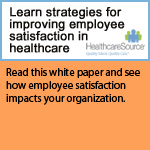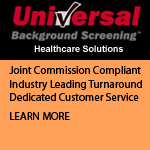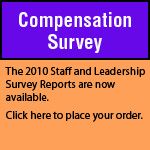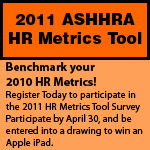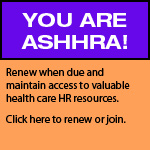| October 14, 2010 | Printer Friendly Version | Advertise | Join ASHHRA | ||

|
PRESIDENT'S MESSAGE
Hello ASHHRA Members
Well, it's done! The 2010 ASHHRA Conference & Exposition is now officially 'history.' Over 800 health care HR leaders and professionals have now returned home, equipped with information, ideas and connections. The ASHHRA staff has returned to Chicago, unpacked their bags, and has begun operationalizing the 2011 ASHHRA strategic plan. The over 175 vendors are sorting through their contact lists, providing requested information, and preparing follow up meetings. All in all, an excellent event unfolded as planned, with nary a problem or hiccup. And yet within this entire ‘normalcy' is the reality that health care reform is moving along - and it's likely the hospital or health care organization you know and work with today will operate dramatically differently by 2015. The ASHHRA conference helped us remember that...and provided invaluable opportunities to learn, discuss, and debate this issue. It'll be interesting to see what will have changed within our worlds 'by the time we get to Phoenix' (as Bob Walters so ably sang) at the conference in September, 2011! Until then, stay with ASHHRA throughout the year as we bring you on-going educational webinars, information and news about health care reform, and more. Thank you for your membership and support! Jeff Payne, SPHR Vice President, Human Resources Lakeland Regional Medical Center 1324 Lakeland Hills Boulevard Lakeland, FL 33805-4500 P: 863-687-1045 F: 863-284-1971 ASHHRA NEWS
LEGAL
WORKFORCE
COMPENSATION
GENERAL HR
BENEFITS
PHYSICIANS
MANAGEMENT & LEADERSHIP
ASHHRA NEWS
LEGAL
WORKFORCE
Ninety percent of executive and board of trustee-level positions in health care are held by white/Caucasian employees. This is only one of the findings from a recent benchmarking study, which was conducted by the American Hospital Association’s Institute for Diversity in Health Management (Institute) to track the management of diversity and disparities in health care. When paired with an understanding of diversity’s significance in health care, the Institute’s findings beg the question: What are health care organizations doing to promote diversity in leadership?
According to the study, which was funded by a three-year grant from the Aramark Charitable Fund at the Vanguard Charitable Endowment Program, health care organizations are taking advantage of a variety of methods to identify qualified individuals from diverse racial and ethnic communities for leadership positions. The most common approach includes networking/proactive outreach attempts to professional associations. Of the 182 health care organizations that responded to the online survey, 80 percent use networking/proactive outreach to professional associations to identify potential candidates. Of those who replied affirmatively, 37 percent specifically cited the local Chamber of Commerce. "The benefits of networking to find diverse candidates for leadership and governance positions are numerous and enduring," said Fred Hobby, president and CEO of the Institute. "The institute itself used networking extensively when sourcing candidates for the American Hospital Association's recently launched Minority Trustee Recruitment and Training program. We were introduced to new contacts and additional professionals who became interested in becoming involved in other institute programs beyond those of our initial appeal. Approximately 70 percent of participating health care organizations take advantage of their relationships with local corporations and community leaders. Results indicated that only 30 percent of organizations use advocacy groups. The University of New Mexico Hospital, which the study listed as having one of the top-ten most diverse boards, indicated the use of networking/proactive outreach and of corporations/community leaders. The organization also focuses on additional diversity-promoting initiatives. "What we have done," said Jamie Silva-Steele, Administrator of Ambulatory Services, "is ensured that hiring managers have been trained in Equal Employment Opportunity and are aware of the unique needs to their patient population that may drive hiring diverse job candidates (i.e., bilingual or multilingual staff, etc.)." The University of New Mexico Hospital is not alone in choosing to use methods other than networking/proactive outreach attempts to professional associations, corporations and community leaders and/or advocacy groups; 15 percent of the study’s respondents said they use additional methods, as well, which range from advertisements, to personal relationships, to internal recruiting. Kevin Sheridan, CEO of HR Solutions, Inc., which created the study’s survey instrument and conducted the analysis of the results, explained the importance of being proactive in diversity promotions, regardless of the method. "Diversity in health care leadership is particularly important: A team made up of leaders from various ethnical backgrounds is able to reflect the diverse racial and ethnic communities of its patients," he said. The institute’s study indicated that black/African-American employees comprise the largest racial/ethnic group among health care leadership after white/Caucasian employees. Black/African-American employees comprise approximately 8 percent of leadership teams; they are followed by Hispanic/Latino employees at 5.5 percent. Native Hawaiian and other Pacific Islander employees are the least represented ethnic group, comprising only 0.25 percent of executive and board of trustee-level individuals. However, the survey results highlight that health care organizations are making progress. In the 12 months prior to the study, health care organizations had an average of 4.7 executive-level vacancies, 2.7 of which were filled with minorities or females. Additionally, the majority of respondents indicated that they had hired or promoted a female or minority for 55 percent of executive-level vacancies in the past 12 months. This illustrates that health care organizations trying to promote diversity in their workforce are producing successful results. As organizations continue along this path, the health care field will experience the benefits of diverse leadership and will become more representative of the people it serves. "It seems that everyone is interested in the future direction of health care," said Hobby. "As we raise awareness about the diversity activities emerging in the health care field, organizations are continuing to pledge their support." Kristy Erdodi is an independent marketing, communications and public relations consultant for HR Solutions, Inc. She can be reached at kristy.erdodi@gmail.com or 248-931-1497. COMPENSATION
GENERAL HR
BENEFITS
The battle cry is on for health care employers: by 2010, they must fill more than 14 million jobs – up from 10.9 million in 2000. Not only will they be further squeezed when the 78 million baby boomers begin to need more medical services, but the upcoming generations won’t have the numbers to replace retiring boomers. So what is a health care organization to do? Unfortunately, if you are like the majority of executives, you are holding your breath and waiting for a crisis to hit. AARP data shows that 60 percent of CEOs and top management have not formally conducted any strategic workforce planning. And in health care, the need is more critical. Consider this: in 2003, 25 percent of the workforce was age 50 and older; by 2012, that figure will rise to 31 percent. And while there is a definite delay of retirement plans by Boomers negatively affected by the economic crisis, the numbers still loom large. Competition within the health care industry will be fierce for those experienced and valuable Boomers who want to continue to work in the field. What value propositions are you offering those employees whom you want to retain? According to ASHHRA research, hospitals fail to meet the expectations of their staff more often than workers in other industries. 89 percent of hospital CEOs report substantial vacancies, with the great shortages coming in registered nurses, radiology/nuclear imaging, technicians and pharmacists. Additionally, a recent Aging Workforce Survey shows that there is little evidence of any strategy for retaining nurses. But it isn’t all bad news. When it comes to being proactive about attracting mature workers, health care as an industry is well ahead of the curve, as reflected by its continued strong presence on the AARP Best Employers for Workers over 50 award. The field is creating and testing innovative programs to retain, retrain, and reskill mature workers and coax others out of retirement. As the AHA Commission on Workforce for Hospitals and Health Systems points out: "The workforce shortage will not be solved unless current and new workers are retained in hospitals." In order to address this issue, AARP convened a health care forum with leaders from premier hospitals and health care systems and associations. Five areas of focus emerged as focal points for health care organizations who wish to take a closer look at 50+ workers as one solution to the workforce crisis; a good starting point. One recommendation included offering wellness and work/life benefits. For many health care workers, these benefits are a lifeline and what allows them to remain on the job or decide to join a company. Some of these benefits include wellness initiatives, flexible work arrangements, including part-time or flextime, elder care support, and life planning courses. Training and reskilling is another way to keep experienced staff on the job. Training, tuition reimbursement, retraining and reskilling (formal courses or programs leading to new certification) programs are a draw for current and potential workers. In health care, technology will become essential for many tasks, and organizations should be providing the training to employees to master new technology. Another recommendation focused on environment and tools. A healthy environment is an incentive for workers of all ages to stay on the job and benefit from a safer, more accommodating workplace. Equipment and work tools, as well as policies and procedures, will need to be designed to reduce strain and prevent injury. In fact, statistics show that three of the 10 most injury prone jobs in the United States are in the nursing profession, and the U.S. Department of Labor calculates that facilities can save an average of $27,700 every time a severe back injury is averted. One of the primary reasons for taking or leaving a job is compensation and benefits. Like all employees, mature workers want access to a solid pension plan, a generous match amount for their 401(k) plan and comprehensive health care coverage and salaries that are competitive. Ultimately, it is meaningful work that ties all of these things together. Meaningful work has been closely linked to employee engagement, as well as to job satisfaction and motivation. According to an AARP study, there is a direct connection between high engagements levels and increased revenue, decreased turnover, and positive customer experiences. Ask yourself: is my organization paying attention to these issues? A simple way to assess whether your organization is on track is to take the free AARP Workforce Assessment Tool. This is an HR professional’s "go-to tool," providing a concise, strategic, and simple way to assess your workforce demographics. Free and confidential, this 30 minute, on-line tool provides your organization with the intelligence you will need to make important business decisions by reviewing your policies around many of the issues identified as being crucial to retention and recruitment. But the tool doesn’t stop there. Once complete, it provides you with a visual summary of your workforce demographics, suggestions on how to initiate strategic plans to address workplace needs, and resources to help you accomplish these goals and ensure your company’s future viability. It will provide you with concrete and actionable steps to help you enhance your infrastructure, introduce new programs, and update policy to reflect best practices for knowledge and talent retention. When the call to action comes for you to assess your current talent and plan strategically for the future, you will have an important resource available at your fingertips. As a human resource professional, you should be at the helm of strategic talent management initiatives that will keep your organization profitable and productive in the challenging years to come. Check out our free, downloadable resources for employers, including the Workforce Assessment Tool and a free training on Recruiting and Retaining the Older Worker, at www.aarp.org/erc. MANAGEMENT & LEADERSHIP
|
ASHHRA Mission To advance the human side of health care, the American Society for Healthcare Human Resources Administration (ASHHRA) leads the way for highly effective, valued, and credible leaders. Contact: ASHHRA FOLLOW US ON |
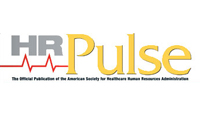
|

|
 |
155 North Wacker, Suite 400 Chicago, IL 60606 Ph.: 312.422.3720 Fax: 312.422.4577 E-mail: ashhra@aha.org Website: www.ashhra.org |




